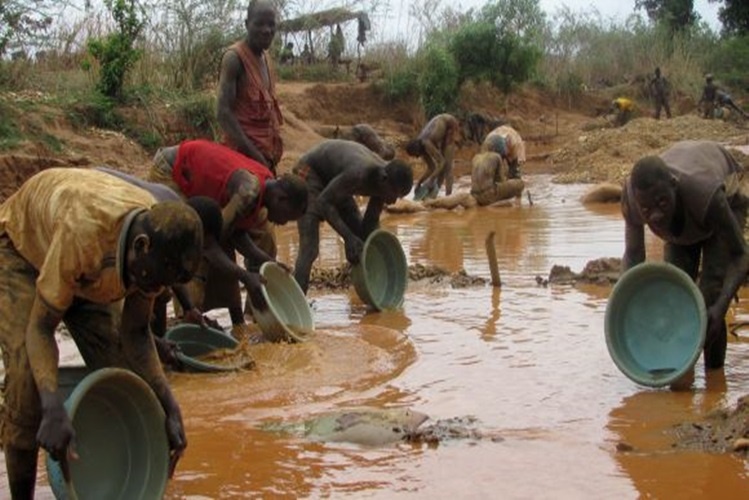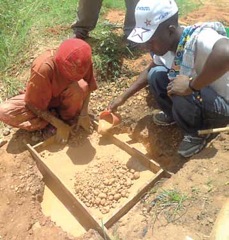In
the Maninge Nice pit, the ground is literally littered with rubies. They sit in
among the dirt, throwing up glints of red and pink. We play a somewhat novel
game – who can collect the most stones in the space of a few minutes – but it’s
too easy. I get to a handful before becoming steadily distracted by the
magnitude of it all.
I
am with a group of journalists in Mozambique’s northeastern Cabo Delgado
Province, at the Montepuez Ruby Mine. Lauded as the most significant
ruby-deposit discovery of recent times, about 50 per cent of the world’s ruby
supply now comes from this mine. "Montepuez Ruby Mine covers over 33,000
hectares, making it the world’s largest ruby deposit," explains Rupak Sen,
director of marketing and sales, Asia and Middle East, for Gemfields, which
owns a 75 per cent stake in the mine. "Although the deposit was only
discovered in 2009, the rubies at the Gemfields Montepuez deposit have been
established as approximately 500 million years old."
To
boot, some of the rubies found here are of a quality previously only thought
possible in gemstones from Myanmar. "They are comparable with the
legendary ‘pigeon blood’ rubies of Myanmar, which frequently command the
highest price per carat of any coloured gemstone," says Sen.
Getting
to the mine is no easy task, of course. There are flights from Dubai to
Tanzania and then onto Pemba, on Mozambique’s northern coast – where a tiny
airport and convoluted entry process highlight the area’s limited number of
tourist arrivals – and then a lengthy drive that takes us through acres of
untamed land, past abandoned colonial-era buildings and villages made of mud
huts.
The
following morning brings expansive horizons and clear, uninterrupted blue skies
– the kind that seem specific to Africa – along with a tour of the Montepuez
Ruby Mine. It’s a revelation. The mining industry has a notoriously bad
reputation, but here we are greeted with signs such as: "Stop, think,
act" and "Safety awareness saves lives", highlighting Gemfields’
aim of operating a zero-accident mine.
Every
employee we see is appropriately dressed and equipped; and there is only
minimal visible damage to the landscape, courtesy of Gemfields’ practice of
filling in old pits as mining teams move along, replanting local plant species
to bring verdant cover back to the land. We contribute to this process during
our stay, with each member of the group planting a tree as a marker of our time
spent here.
Rubies
were first discovered in Montepuez in 2009. As the story goes, a man working
the land, which was formerly a hunting concession, happened across one of the
red stones. Given the volume of rubies that we see during our trip, it seems
incredible not that they were discovered, but that they managed to remain
hidden for so long. The local owners of the land contacted Gemfields; they had
heard about the success of the company’s ethically operated emerald mine in
Zambia and wanted to replicate the model in Mozambique. Gemfields acquired a 75
per cent stake in the mine and arrived on-site in 2012.
The
team remembers trying to decide where to place their camp. They picked a spot,
started digging a hole for the latrine and promptly unearthed handfuls of
rubies. The jokingly dubbed "million-dollar toilet" stayed, and is
now flanked by the Sort House, but the camp was moved farther away.
The
sheer number of rubies here makes the mining process relatively
straightforward. This is open-pit mining – in simple terms, mountains of rich
red earth are scooped up in enormous diggers, transported to the wash plant and
processed. The rubies are then picked out from the resultant gravel by hand.
Mining
may be a controversial business, but there’s magic in it, too. There is
something indescribable about picking up a ruby and knowing that it has sat
under the Earth’s surface for hundreds of millions of years – that you are the
first person to ever touch it.
While
diamonds have dominated the market for the best part of the past century,
rubies have been coveted by certain cultures throughout the ages. "Rubies
were treasured by early cultures as they represented the redness of the blood
that flowed through their veins, and many believed that rubies held the power
of life and so were often carried into battle for protection," says Sen.
"In fact, the ruby has always been highly esteemed in Oriental countries,
being regarded as endowed with extraordinary powers. As western empires rose to
power, rubies became the favoured gemstones of European royalty and
aristocracy.
 "However,
the advent of feisty diamond marketing, backed by consistent supply, in the
past three or four decades, took coloured gemstones to the background, while
diamonds took centre stage. This is now changing, with leading jewellery brands
like Chopard, Bvlgari, Cartier et al launching exclusive coloured-gemstone collections,
and with increasing incidence of ruby and emerald jewellery being sported by
celebrities around the world."
"However,
the advent of feisty diamond marketing, backed by consistent supply, in the
past three or four decades, took coloured gemstones to the background, while
diamonds took centre stage. This is now changing, with leading jewellery brands
like Chopard, Bvlgari, Cartier et al launching exclusive coloured-gemstone collections,
and with increasing incidence of ruby and emerald jewellery being sported by
celebrities around the world."
If
the tide is turning, Gemfields must be given its dues. It can now offer a
consistent supply of rubies to manufacturers and polishers, with the promise
that they have been ethically sourced and are of a guaranteed quality. Much as
it did with emeralds in Zambia, the company has also created the first official
classification system for rubies, which in addition to the standard four Cs (colour,
clarity, cut and carat) that will be familiar to any diamond buyer, includes
two other Cs: certification and character.
 Beyond
logistics, Gemfields’ global marketing campaigns are contributing to creating
an aura of covetability around coloured gemstones once again. Its latest
marketing campaign, Ruby-Inspired Stories, offers a triptych of films that
explore three properties that rubies have long been associated with: passion,
prosperity and protection.
Beyond
logistics, Gemfields’ global marketing campaigns are contributing to creating
an aura of covetability around coloured gemstones once again. Its latest
marketing campaign, Ruby-Inspired Stories, offers a triptych of films that
explore three properties that rubies have long been associated with: passion,
prosperity and protection.
In
fact, unbeknownst to many, rubies are much rarer than other precious stones. At
present, the world ruby supply consists of about three million cut and polished
carats per year, compared to about five to eight million for emeralds and 50
million for diamonds, according to Ian Harebottle, chief executive of
Gemfields.
But
the company’s aim is not for coloured gemstones to overtake or replace diamonds
in the public consciousness, but to create more balance and choice in the
market. "The decade starting 2015 was actually billed as the decade of the
coloured gemstone," says Sen, when asked whether he envisages a time when
coloured gemstones will surpass diamonds in popularity. "Every time a
consumer buys a coloured gemstone, diamonds are sold alongside. Coloured
gemstones and diamonds complement each other, and that’s the way it will always
be," he says.
 Gemfields
held its first ruby auction in Singapore in June 2014, and generated US$33.5
million (Dh123m). At its latest ruby auction in June, the company generated
record revenues of $44.3m (Dh162.7m), with an average realised price of $29.21
(Dh107) per carat.
Gemfields
held its first ruby auction in Singapore in June 2014, and generated US$33.5
million (Dh123m). At its latest ruby auction in June, the company generated
record revenues of $44.3m (Dh162.7m), with an average realised price of $29.21
(Dh107) per carat.
There
is much talk during our time in Mozambique about the "1 per cent".
Not the 1 per cent, that top layer of society that holds a disproportionate
share of global wealth (although that is an unfortunate parallel) – but the 1
per cent of Gemfields’ annual revenue that it donates to CSR initiatives. The
number feels small to me – as small as it can be, almost.
I
put this point to Harebottle. "Our commitment is a minimum of 1 per
cent," he says. "We are working with a luxury good in unstable
economies. We are very fortunate that through our efforts we are constantly
growing, but there are no guarantees. When I make a commitment, I have, to the
very best of my ability, barring any major catastrophes, to be sure that I am
able to keep that commitment."
The
point, of course, is that whether you are talking about 1 per cent or 100 per
cent, sustainability needs to be sustainable, or else it is entirely
counterproductive. "When people ask me about our investment in
sustainability, I say: ‘The one thing I can tell you is it doesn’t mean we are
perfect and it doesn’t mean we are doing enough.’ I’ve lived in Africa and I
know there is not a company or individual in the world that can do enough,
because the needs are so great.
"The
one thing I do know, 100 per cent, is that the areas we are in are better for
us being there. We’re doing the best we can, recognising it’s not enough and
constantly trying to do better."
And
I am reminded on numerous occasions how even one per cent can make a major
difference in a place like Mozambique. We visit some of the projects that the
company is investing in – they are very real grass-roots initiatives.
"After collaboration with the local community, a farming association was
recently formed producing beans, okra and various other vegetables. Currently,
most of the produce is being bought back by the company, where it is purchased
at market prices and used for the sustenance of its own employees," Sen
explains. "A poultry-farming cooperative has been formed at a nearby
village with a view to further empower women in the area. Going forward,
initiatives based around education (including a new skills and development
centre), health care and the provision of clean drinking water will also be put
in place. Conservation is also a focus."
In
a perfect world, Gemfields would not be an anomaly. Its ethical approach to
mining would be the industry norm. But we do not live in a perfect world, so
Gemfields must be lauded for its efforts. It is the only supplier of coloured
gemstones that has built a holistic business model that places importance on
people and the planet, as well as profit. It is introducing transparency in an
industry where, traditionally, there has been none.For
the first time, you can buy a ruby and know exactly where it has come from, and
that it was mined in a way that is respectful of local populations. And in this
imperfect world, that’s basically priceless.
*Read
this and more stories in Luxury magazine, out with The National on Thursday,
November 3.


1 comentários:
Invest with 200$ and get a returns of 5,000$ within seven business working days.
Why wasting your precious time online looking for a loan? When there is an opportunity for you to invest with 200$ and get a returns of 5,000$ within seven business working days. Contact us now for more information if interested on how you can earn big with just little amount. This is all about investing into Crude Oil and Gas Business.
Email:investmetoil.gasfinancial363@gmail.com
Post a Comment